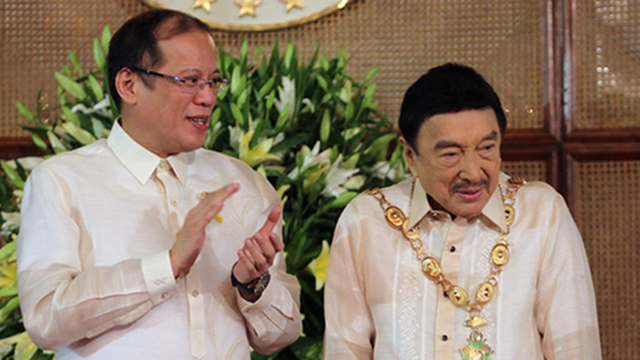SUMMARY
This is AI generated summarization, which may have errors. For context, always refer to the full article.

MANILA, Philippines – Not only a comedian, the late Rodolfo “Dolphy” Quizon Sr was also the recipient of government recognitions like the Grand Collar of the Order of the Golden Heart, one of Malacañang’s highest awards.
The City of Manila on Wednesday, July 11, thus directed all schools and government offices to display flags in half-mast in honor of Dolphy, a Manila city awardee, who died a day earlier due to a lingering illness. (Read: Dolphy is dead at 83.)
In a memo, Manila Mayor Alfredo Lim noted Dolphy’s prestigious status in his own locality, which recently awarded him the recognition Gawad Diwa ng Lahi.
The Flag and Heraldic Code of the Philippines allows the national flag to be flown at half-mast in exceptional circumstances.
These include the death of the Philippine President, other top officials, and other persons to be determined by the National Historical Commission of the Philippines (NHCP). On its website, the NHCP also allows flying the flag at half-mast to mourn “recipients of medals, national orders and decorations, on the day of interment and by order of the President or the Congress.”
Palace mulling idea
Communications Undersecretary Manuel Quezon III, a historian, told Rappler a presidential proclamation is required to fly the national flag at half-mast in the Philippines. The matter “is being studied” by the Palace, Quezon said.
Local government units have decided to fly their flags at half-mast “many times as it covers their territory,” he explained.
Meanwhile, the Philippines sets different rules for using the flag to cover caskets.
“The flag may be used to cover the caskets of the honored dead of the military, veterans of previous wars, national artists, and of civilians who have rendered distinguished service to the nation, as may be determined by the local government unit concerned,” the Flag and Heraldic Code of the Philippines says.
Other politicians have planned their own tributes for Dolphy.
In a statement, Eastern Samar Rep Ben Evardone proposed declaring July 10 as “Dolphying Day” or “Filipino Fun Day” to commemorate Dolphy.
Evardone said such an observance “is the least we Filipinos, individually and collectively touched by the “Comedy King,” can return for every good laugh Tito Dolphy drawn out from us.”
Even when Dolphy was alive, however, government critics have demanded the most prestigious recognition for artists like him: the National Artist Award. He was nominated for the award in 2010, but was denied by the selection committee. (Read: Why Dolphy is not yet a national artist.)
Former President Joseph Estrada, as well as Dolphy’s other supporters, said the award is “long overdue.” – Rappler.com
Related stories:
Elsewhere in Rappler:
- [Nation] QC to have two additional districts
- [Thought Leaders] Mining E.O. not perfect, but very good by Dean Tony La Viña and Atty. Alaya De Leon
- [Entertainment] Why Dolphy is not yet a National Artist
- [Sports] The Philippine collegiate rivalry: NCAA vs UAAP
- [World] ASEAN struggles over maritime dispute with China
Add a comment
How does this make you feel?
There are no comments yet. Add your comment to start the conversation.